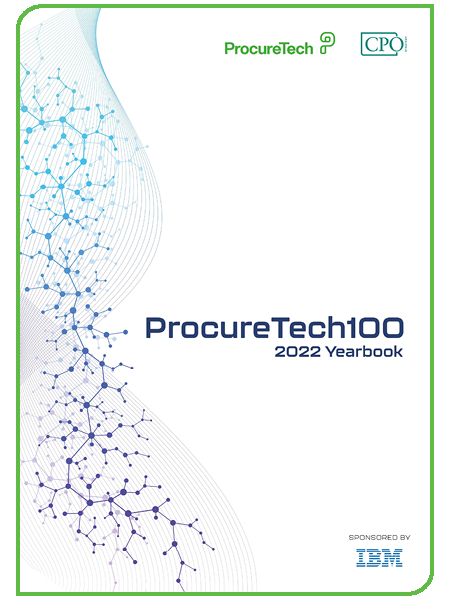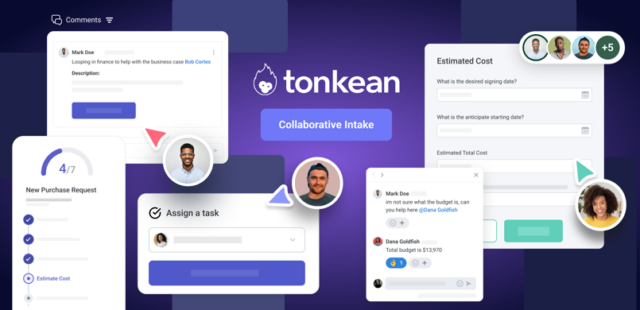What were the top procurement trends in 2022?
The pace of evolution of the procuretech ecosystem continues to inspire the industry and we have seen digital procurement leaders rise in challenging times. So, what were the top procurement trends in 2022?

Last year’s ProcureTech100 cohort has outperformed their peers with over 40% growing exponentially, introducing new innovation, new partnerships and alliances. The 2022 ProcureTech100 cohort continue this drive with the most significant growth rate compared to their peers being in companies under 100 employees in size. Over 60% of the digital procurement ecosystem is made up of companies with under 50 employees with there being a clear step up required to building teams with over 50 employees. This correlates with the level and pace of funding within procuretech too and the step up to Series A.
Sign-up now to receive the FREE 2022 Yearbook, full of more useful insights.
Trends – Digitalisation drivers
Agility, decision making, risk and collaboration drive the digitisation of procurement
65% of companies see digitalisation as being important to achieve their company and procurement objectives.
The key drivers for this digitalisation are process agility and decision making (79%), transparency, compliance and risk (78%), and supplier or partner collaboration (70%). Leaders see optimising cost and cash flow as well as improving compliance and risk as key drivers to digitalise, priorities that mirror the current 2022 global challenges.
Whilst we are living in post pandemic times and in the middle of supply chain shortages, digitalisation to help secure supply, is not seen as significant driver. Immediate issues have been addressed through the application of corporate and supplier talent. We would anticipate that this will change in the next 12-18 months through the introduction of new digital solutions to help solve these issues.
For large companies, with over 5,000 people, the digital drivers are focused on increased decision agility and risk compliance, whereas for smaller companies, less than 200 people, the drivers were stronger supplier or partner collaboration and improved transparency.
Driving revenue growth and optimising product/service demand were also evaluated as relatively low reasons to digitise. For future leaders addressing demand management will increase the importance of optimising product or services demand through greater access to data and application of digitalisation.
1 – New digital procurement categories and capabilities are emerging
As procurement’s scope continues to expand both across the company and through the supply chain, the great ‘unbundling’ of procurement continues too. This unbundling is characterised by the application of digital to either existing or new capabilities and skills. As a result we have seen the rapid emergence of point solutions to digitalise these areas from Candex for tail spend transactions to Scoutbee for supplier discovery. Their success is driven through the simplicity of the user experience which is enabled by advanced technology (which the user never sees). The application of point solutions extends to enablement through data too, for example Keelvar’s sourcing optimisation solution uses ocean and air freight benchmarking and market analytics from Xeneta, and Lytica is a standalone solution for electronic component spend analytics and risk intelligence enabled by real customer data.
The unbundling and digitalisation continues into existing and new categories too, with many new category specific solutions evolving. As companies digitalise their buying and supply channels it is possible to apply point solutions (if the volumetrics work) to most categories. Globality’s approach to services shifts the whole delivery model addressing both capacity and capability constraints. Niche solutions like Lightyear for Telecoms procurement and Zluri for SaaS procurement go deep within subcategories, often combining software with services to provide a point of differentiation and extending from the buying to management of solutions too.
“ We have spent the last decade creating toy boxes, now we have to create toolboxes that have the process, skills and culture integrated. My favourite tool box is for adoption.” Amanda Davies, Mars
2 – From interface to database
Traditionally, there is much focus by procurement on the ‘app layer’ that delivers the end to end capability. It is essential for procurement to be aligned with corporate digital and IT teams to design and deliver the whole procuretech stack. At the top of the stack the ‘interface’ and starting point of the user journey for buyers, suppliers, business users, chat bots and functional experts should be defined. Beyond a simple portal, Kore. ai can provide this conversational interface as a multichannel interface into procurement.
Often this also integrates your procurement process orchestration and intelligence layers which are either embedded or connected to your app layer. There are significant improvements in user experience through the deployment of tools like ZIP and UIPath which provide this orchestration and have established integration.
The ‘middleware’ layer that connects apps including your ERP system to data can be provided by solutions like HICX, apexanalytics and Oro. Into this advanced companies are augmenting their data layer and foundation with AI and ML from solutions like Creactives and TealBook
Get started defining your procuretech stack and fungible data fabric!
3 – Best of All ecosystem of solutions
Fact: There is no equivalent of ERP for all of procurement. There is no equivalent of PLM for procurement.
As procurement’s role has expanded so have our digital and data needs. Each and every procurement team has an accountability to define their own digital procurement operating platform. This platform should consider ALL solutions, from the capabilities provided by traditional ERP and finance solutions to the latest process workflow, apps and data solutions. From this your own ‘Best of All’ solutions ecosystem will emerge.
This trend is happening across procurement and also within individual capabilities with procurement too. Especially those areas with multiple user journeys and many data feeds. This is creating ‘micro’ platforms.
“There is no one-stop shop to cover risk management end-to-end, we will likely require an ecosystem within an ecosystem, including one for risk apps within the broader digital ecosystem. The market is moving away from one solution does it all to ecosystem suites with central management and focussed solutions for specialist areas such as: Supply Chain Visibility, Mapping or Traceability; Cyber; Finance Etc. This is reflected in the spread of different solutions here across the ProcureTech100. The ‘winners’ will likely be the ones who best integrate in this ecosystem, and also transparently with ESG, ERP and other ProcureTech areas.” Tim Perry-Ogden
4 – Digital supply and demand more in balance
Over the last 10 years the supply of digital procurement solutions has rapidly increased. If you had asked for a blockchain solution to help with the provenance of goods 10 years ago you would not have been able to find a solution – now you can. For most of the current and new use cases you can now find the digital procurement solutions that you need. Moreover, in many areas there are now multiple digital procurement solutions providing companies with choices for their digital procurement operating platform. Where digital solutions don’t quite meet what you need then many digital solutions are prepared to flex their product roadmap to align with those needs.

Fuelled by investment
The venture investment into procuretech continues to grow, there are over 1,000 venture capitalists with single investments and increasing numbers of B2B investors that have multiple investments into procuretech.
Procurement teams are also clear on the investment required, the ROI and how quickly this needs to be achieved.
“We must go on this investment journey … we may need to tighten our belt in other areas but digitalisation is not one of them.” Marielle Beyer, Roche
📢 Sign-up for full access to the ProcureTech100 2022 Yearbook for the full report and more insightful articles!











